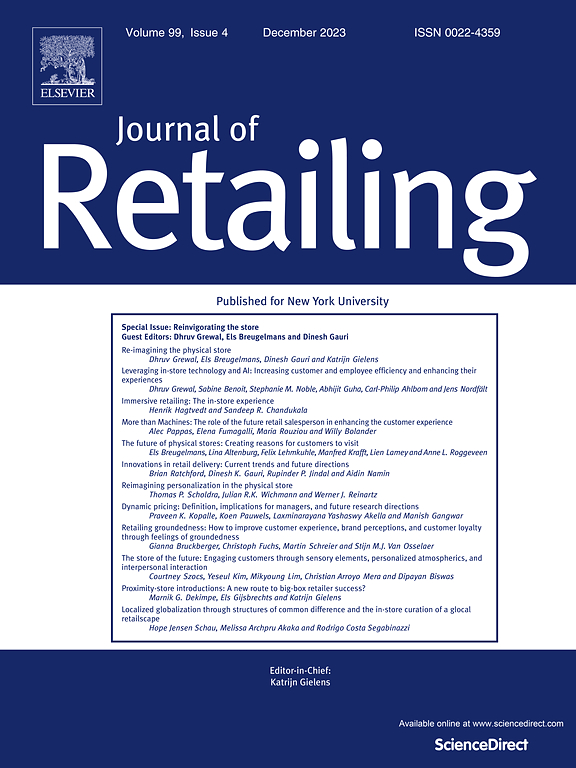VR零售:沉浸式体验何时以及为何会带来回报
IF 10.2
1区 管理学
Q1 BUSINESS
引用次数: 0
摘要
随着沉浸式虚拟现实(VR)越来越多地融入零售业,了解它何时以及为什么比非沉浸式替代品更有价值,对于做出投资决策至关重要。本研究明确了沉浸式VR增强消费者购买意愿的条件,以及非沉浸式VR可以作为成本效益替代品的条件。研究结果表明,当产品交互性较低时,沉浸式VR优于非沉浸式VR,因为沉浸式环境弥补了有限的消费者产品交互。然而,在高交互性下,沉浸式VR的有效性取决于产品类型和感官设计。对于可抓取的产品,沉浸式VR始终有助于购买,无论是否存在触觉线索。相比之下,对于不可抓取的产品,沉浸式VR只有在触觉提示可用时才会产生优势。如果没有这种触觉反馈,非沉浸式VR也会变得同样有效,并提供更具资源效率的解决方案。这些见解挑战了“更具沉浸感的技术本质上更好”的假设。相反,沉浸式VR的好处取决于消费者如何与不同的产品互动,以及感官输入是否符合体现的期望。从管理角度来看,研究结果为将VR投资与产品特性相结合提供了战略指导。零售商应该考虑有选择地采用沉浸式VR,特别是在交互性较低的环境中,或者在展示可抓取的产品时。当产品触感有限或触觉线索不可行时,非沉浸式VR提供了一个可行且可扩展的替代方案。这项研究为优化VR零售策略提供了可操作的见解,使公司能够以增强消费者理解和推动购买结果的方式定制技术使用。本文章由计算机程序翻译,如有差异,请以英文原文为准。
VR retailing: When and why immersion pays off
As immersive virtual reality (VR) becomes increasingly integrated into retail, understanding when and why it delivers value over non-immersive alternatives is crucial for making investment decisions. This research identifies the conditions under which immersive VR enhances consumer purchase intention and when non-immersive VR can serve as a cost-effective substitute. The findings demonstrate that immersive VR outperforms non-immersive VR when product interactivity is low, as the immersive environments compensate for limited consumer-product interaction. However, under high interactivity, the effectiveness of immersive VR depends on product type and sensory design. For graspable products, immersive VR consistently facilitates purchase regardless of whether haptic cues are present. In contrast, for non-graspable products, immersive VR only yields an advantage when haptic cues are available. Without such tactile feedback, non-immersive VR becomes equally effective and offers a more resource-efficient solution. These insights challenge the assumption that more immersive technology is inherently better. Instead, the benefits of immersive VR depend on how consumers engage with different products and whether the sensory inputs match embodied expectations. From a managerial perspective, the findings provide a strategic guide for aligning VR investment with product characteristics. Retailers should consider adopting immersive VR selectively, especially in low-interactivity contexts or when presenting graspable products. When product tactility is limited or haptic cues are not feasible, non-immersive VR offers a viable and scalable alternative. This research delivers actionable insights for optimizing VR retail strategies, enabling firms to tailor technology use in ways that enhance consumer understanding and drive purchase outcomes.
求助全文
通过发布文献求助,成功后即可免费获取论文全文。
去求助
来源期刊

Journal of Retailing
BUSINESS-
CiteScore
15.90
自引率
6.00%
发文量
54
审稿时长
67 days
期刊介绍:
The focus of The Journal of Retailing is to advance knowledge and its practical application in the field of retailing. This includes various aspects such as retail management, evolution, and current theories. The journal covers both products and services in retail, supply chains and distribution channels that serve retailers, relationships between retailers and supply chain members, and direct marketing as well as emerging electronic markets for households. Articles published in the journal may take an economic or behavioral approach, but all are based on rigorous analysis and a deep understanding of relevant theories and existing literature. Empirical research follows the scientific method, employing modern sampling procedures and statistical analysis.
 求助内容:
求助内容: 应助结果提醒方式:
应助结果提醒方式:


